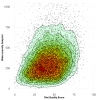Diet Quality and Water Scarcity: Evidence from a Large Australian Population Health Survey
- PMID: 31404949
- PMCID: PMC6723970
- DOI: 10.3390/nu11081846
Diet Quality and Water Scarcity: Evidence from a Large Australian Population Health Survey
Abstract
There is widespread interest in dietary strategies that lower environmental impacts. However, various forms of malnutrition are also widely prevalent. In a first study of its kind, we quantify the water-scarcity footprint and diet quality score of a large (>9000) population of self-selected adult daily diets. Here, we show that excessive consumption of discretionary foods-i.e., energy-dense and nutrient-poor foods high in saturated fat, added sugars and salt, and alcohol-contributes up to 36% of the water-scarcity impacts and is the primary factor differentiating healthier diets with lower water-scarcity footprint from poorer quality diets with higher water-scarcity footprint. For core food groups (fruits, vegetables, etc.), large differences in water-scarcity footprint existed between individual foods, making difficult the amendment of dietary guidelines for water-scarcity impact reduction. Very large reductions in dietary water-scarcity footprint are possible, but likely best achieved though technological change, product reformulation and procurement strategies in the agricultural and food industries.
Keywords: dietary guidelines; discretionary food; life cycle assessment; sustainable diet; sustainable food production; sustainable food systems; water footprint; water use.
Conflict of interest statement
The authors declare no conflict of interest. The authors exercised freedom in designing the research, performing the analyses and making the decision to publish research results. Meat and Livestock Australia (MLA) partially funded this research. However, MLA did not have any role in design of the study, analysis of results or interpretation of results. The decision to publish was made prior to funding and before the results were known. MLA had no role in the preparation of the manuscript.
Figures



References
-
- The Global Risks Report 2017. 12th ed. World Economic Forum; Geneva, Switzerland: 2017.
-
- Greve P., Kahil T., Mochizuki J., Schinko T., Satoh Y., Burek P., Fischer G., Tramberend S., Burtscher R., Langan S., et al. Global assessment of water challenges under uncertainty in water scarcity projections. Nat. Sustain. 2018;1:486–494. doi: 10.1038/s41893-018-0134-9. - DOI
-
- Transforming Our World: The 2030 Agenda for Sustainable Development. United Nations General Assembly; New York, NY, USA: 2015. A/RES/70/1.
-
- Verones F., Pfister S., van Zelm R., Hellweg S. Biodiversity impacts from water consumption on a global scale for use in life cycle assessment. Int. J. Life Cycle Assess. 2017;22:1247–1256. doi: 10.1007/s11367-016-1236-0. - DOI
MeSH terms
Grants and funding
LinkOut - more resources
Full Text Sources

